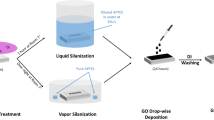Abstract
The three-dimensional porous network polytetrafluoroethylene (PTFE) thin films were achieved by a vacuum technique through evaporating the pure PTFE powders. The surfaces of PTFE thin films showed various morphologies by adjusting the evaporation temperature and the corresponding contact angle ranging from 133° to 155°. Further analyses of surface chemical composition and morphology by FTIR and FE-SEM revealed that the origin of hydrophobicity for the PTFE thin films could be ascribed to the fluorine-containing groups and the surface morphologies, indicating that abundant -CF2 groups and network structures with appropriate pore sizes played a vital role in superhydrophobicity. By characterization of UV-Vis, the films also showed high transmittance and antireflection effect. The films prepared by this simple method have potential applications such as waterproof membrane and self-cleaning coating.
Similar content being viewed by others
References
Deng X, Mammen L, Butt H J, et al. Candle soot as a template for a transparent robust superamphiphobic coating. Science, 2012, 335(6064): 67–70
Manna U, Lynn D M. Synthetic surfaces with robust and tunable underwater superoleophobicity. Advanced Functional Materials, 2015, 25(11): 1672–1681
Wen L, Tian Y, Jiang L. Bioinspired super-wettability from fundamental research to practical applications. Angewandte Chemie International Edition in English, 2015, 54(11): 3387–3399
Zhu H, Guo Z, Liu W. Biomimetic water-collecting materials inspired by nature. Chemical Communications, 2016, 52(20): 3863–3879
Kannarpady G K, Sharma R, Liu B, et al. Silane decorated metallic nanorods for hydrophobic applications. Applied Surface Science, 2010, 256(6): 1679–1682
Yu S, Guo Z, Liu W. Biomimetic transparent and superhydrophobic coatings: from nature and beyond nature. Chemical Communications, 2015, 51(10): 1775–1794
Chen K, Zhou S, Yang S, et al. Fabrication of all-water-based selfrepairing superhydrophobic coatings based on UV-responsive microcapsules. Advanced Functional Materials, 2015, 25(7): 1035–1041
Wang B, Liang W, Guo Z, et al. Biomimetic super-lyophobic and super-lyophilic materials applied for oil/water separation: a new strategy beyond nature. Chemical Society Reviews, 2015, 44(1): 336–361
Zhu H, Guo Z. Understanding the separations of oil/water mixtures from immiscible to emulsions on super-wettable surfaces. Journal of Bionics Engineering, 2016, 13(1): 1–29
Bayata M E A, Nourmohammadib A, Moshfegha A Z. Wettability properties of PTFE–ZnO nanorods thin film exhibiting UVresilient superhydrophobicity. Applied Surface Science, 2015, 341: 92–99
Kamegawa T, Shimizu Y, Yamashita H. Superhydrophobic surfaces with photocatalytic self-cleaning properties by nanocomposite coating of TiO2 and polytetrafluoroethylene. Advanced Materials, 2012, 24(27): 3697–3700
Bhushan B, Jung Y C. Natural and biomimetic artificial surfaces for superhydrophobicity, self-cleaning, low adhesion, and drag reduction. Progress in Materials Science, 2011, 56(1): 1–108
Zhang P, Lv F Y. A review of the recent advances in superhydrophobic surfaces and the emerging energy-related applications. Energy, 2015, 82: 1068–1087
Jafari R, Menini R, Farzaneh M. Superhydrophobic and icephobic surfaces prepared by RF-sputtered polytetrafluoroethylene coatings. Applied Surface Science, 2010, 257(5): 1540–1543
Nakajima A, Fujishima A, Hashimoto K, et al. Preparation of transparent superhydrophobic boehmite and silica films by sublimation of aluminum acetylacetonate. Advanced Materials, 1999, 11(16): 1365–1368
Nishino T, Meguro M, Nakamae K, et al. The lowest surface free energy based on–CF3 alignment. Langmuir, 1999, 15(13): 4321–4323
Liu C, Fairhurst R G, Ren L Q, et al. Co-deposition of titanium/polytetrafluoroethylene films by unbalanced magnetron sputtering. Surface and Coatings Technology, 2002, 149(2–3): 143–150
Nishino T, Meguro M, Nakamae K, et al. The lowest surface free energy based on–CF3 alignment. Langmuir, 1999, 15(13): 4321–4323
Kim H M, Sohn S, Ahn J S. Transparent and super-hydrophobic properties of PTFE films coated on glass substrate using RFmagnetron sputtering and Cat-CVD methods. Surface and Coatings Technology, 2013, 228(S1): S389–S392
Gonon A T, Bulhak A, Bröijersén A, et al. Cardioprotective effect of an endothelin receptor antagonist during ischaemia/reperfusion in the severely atherosclerotic mouse heart. British Journal of Pharmacology, 2005, 144(6): 860–866
Bao S, Tajima K, Yamada Y, et al. Polytetrafluoroethylene (PTFE) top-covered Mg–Ni switchable mirror thin films. Materials Transactions, 2008, 49(8): 1919–1921
Bao S, Yamada Y, Tajima K, et al. Optical property and cycling durability of polytetrafluoroethylene top-covered and metal buffer layer inserted Mg–Ni switchable mirror. Solar Energy Materials and Solar Cells, 2009, 93(9): 1642–1646
Miller J D, Veeramasuneni S, Drelich J, et al. Effect of roughness as determined by atomic force microscopy on the wetting properties of PTFE thin films. Polymer Engineering and Science, 1996, 36(14): 1849–1855
Oshima A, Tabata Y, Kudoh H, et al. Radiation induced crosslinking of polytetrafluoroethylene. Radiation Physics and Chemistry, 1995, 45(2): 269–273
Li L, Zi F T, Zheng Y F. The characterization of fluorocarbon films on NiTi alloy by magnetron sputtering. Applied Surface Science, 2008, 255(2): 432–434
Yao B D, Chan Y F, Wang N. Formation of ZnO nanostructures by a simple way of thermal evaporation. Applied Physics Letters, 2002, 81(4): 757–759
Madhukar A, Xie Q, Chen P, et al. Nature of strained InAs threedimensional island formation and distribution on GaAs(100). Applied Physics Letters, 1994, 64(20): 2727–2729
Liang Q, Yan X, Gu Y, et al. Highly transparent triboelectric nanogenerator for harvesting water-related energy reinforced by antireflection coating. Scientific Reports, 2015, 5: 9080
Cassie A B D, Baxter S. Wettability of porous surfaces. Transactions of the Faraday Society, 1944, 40: 546–551
Henry F, Renaux F, Coppée S, et al. Synthesis of superhydrophobic PTFE-like thin films by self-nanostructuration in a hybrid plasma process. Surface Science, 2012, 606(23–24): 1825–1829
Feng X, Jiang L. Design and creation of superwetting/antiwetting surfaces. Advanced Materials, 2006, 18(23): 3063–3078
Liu S, Liu X, Latthe S S, et al. Self-cleaning transparent superhydrophobic coatings through simple sol–gel processing of fluoroalkylsilane. Applied Surface Science, 2015, 351: 897–903
Deng X, Mammen L, Zhao Y, et al. Transparent, thermally stable and mechanically robust superhydrophobic surfaces made from porous silica capsules. Advanced Materials, 2011, 23(26): 2962–2965
Author information
Authors and Affiliations
Corresponding author
Rights and permissions
About this article
Cite this article
Yi, N., Bao, S., Zhou, H. et al. Preparation of microstructure-controllable superhydrophobic polytetrafluoroethylene porous thin film by vacuum thermal-evaporation. Front. Mater. Sci. 10, 320–327 (2016). https://doi.org/10.1007/s11706-016-0343-y
Received:
Accepted:
Published:
Issue Date:
DOI: https://doi.org/10.1007/s11706-016-0343-y




